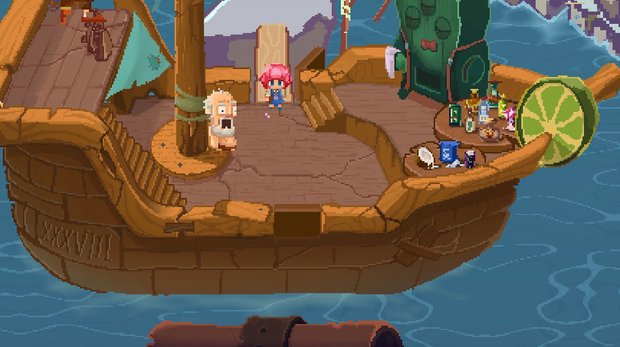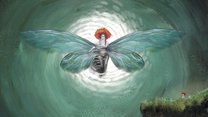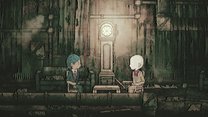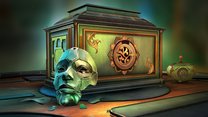Cleo: A Pirate’s Tale review

- 0 Comments
Retro RPG-styled adventure worth digging up for a limited bit of hearty fun
Cleo is a cynical fourteen-year-old girl living a repetitive life with her father in a bar, serving shrimp meals to boring sailors and unsuccessful pirates, watching them swig their rum, and listening to them talk about their dull lives. No teenaged girl would want that! Cleo wants to be more like Captain Cabeca, a famous pirate and adventurer who has sailed the world’s oceans and had all sorts of exciting adventures – adventures that Cleo obsessively reads about in books instead of working, much to the annoyance of her grumpy father.
After a disturbing supernatural occurrence, Cleo’s father has finally had enough of her daydreaming, kicking her out and making her work on a fishing boat. But on her first day the boat is attacked by a kraken and Cleo is shipwrecked on an inhabited island. The rest of Cleo: A Pirate’s Tale tells the story not just of the young protagonist trying to get home, but also searching for a hidden treasure by following a clue given to her by a mysterious voice as her ship sank. It’s a fun little tale overall, let down only by largely budgetary restrictions and a retro-RPG-styled presentation that has some limitations of its own.
Cleo’s adventure begins to unfold as she travels the island she washed up on. Talking with the local Siren, and visiting the mysterious Madame Jichomilele, along with many other varied and interesting local residents (and pirates, of course), she eventually joins forces with Malthe Seus, an old sailor, ship owner, and cocktail specialist, and travels with him (and his parrot) to other islands in search of The Treasure of Eternal Memory.
There are a lot of different locations to visit, one of the more memorable highlights being the McInally Hotel, an island resort with a cocktail lounge, pool, and topless sunbathers. The end goal is finding the treasure and getting home, but there’s no clear path to take, so talking with the people on the islands gives you a clue to the next step. Naturally, before they’ll help you or impart any knowledge they may have, they’ll have a task or two for you to complete, most of which are of the “find this and bring it to me” variety.

Cleo: A Pirate’s Tale is a conversation- and inventory-driven game, where you must pick up necessary items and use them on the appropriate people to unlock dialog options that allow you to progress. In short: talk to everyone, look at everything, and pick up anything not nailed down, and you’ll be fine. The difficulty is very well-balanced; no puzzle is too obscure or too difficult, the main frustration being the age-old adventure game curse of pixel hunting. And in this game, things are easy to miss. A description appears on-screen for any hotspots or characters you can interact with when you walk near to them, but the size of some important objects are so small that you can hardly see them. Without a hotspot highlighter, you’ll need to cover as much ground as possible so you don’t inadvertently overlook anything. One notable and particularly frustrating such case involves trying to pick up a worm that is barely visible.
There is also a nice variety of mini-games that keep the standard puzzles from becoming monotonous. One that you encounter very early on has eight musical notes you must play in the correct order to unlock your reward, and while there is a clue present on a treasure map, it still takes some logical thought to win through. Another notable puzzle involves trying to adjust the fingers of a severed hand that is cradling a book so all the fingers open and the book is dropped. Many documents can be found scattered throughout Cleo, from books to pirate maps and notes, each of which appears as a closeup filling the entire screen. All these different elements helped ensure that the gameplay never felt repetitive during the relatively short four hours it took me to finish.
The most significant mini-game is called Kraken Fodder, a dice and card game where your purpose is to destroy your opponent’s cards with cannon balls. Each game takes about five minutes, and you’ll find plenty of opportunities to perfect your skills as the sailors and pirates you meet throughout your travels will want to play against you. This mini-game is a fun enough diversion except when an extra requirement is added. Unfortunately there are two separate points where winning Kraken Fodder is required in order to progress the story, and the randomness involved means it can easily become unwinnable if you lose certain cards early on. At least if you don’t like your chances at any stage, you can give up and start a new match from the beginning.
Although very much an adventure game, graphically Cleo looks like a classic top-down roleplaying game such as Chrono Trigger. There’s a wide variety of locations you’ll traverse on your journey to find the fabled treasure. Some are swamps that are all different hues of green, with vine-covered trees and putrid stagnant water. Others are tropical islands with sandy beaches, rocky cliffs and lush vegetation. A certain town you’ll visit harkens back to The Secret of Monkey Island in its design and purple colour choices.

The pixel art backgrounds are all well-drawn, but the fact that they imitate that retro RPG look really detracts from my appreciation of them. This art style lends itself to a lot of repetition, which makes all the backgrounds seem same old, same old. Cleo’s father’s bar, for example, looks like every other bar in any number of 90s Super Nintendo games, and that makes it feel quite bland on occasion. And yet while I’m not personally a fan of this style, the artwork here is attractive enough within the designer’s chosen limitations.
Some nicely presented hand-painted cutscenes enhance the visual experience, and though they’re not used for every plot point, they are frequent enough to really add to the overall aesthetic. These are not animated but rather a series of still pictures bordered with a dreamlike watercolour aura, the narrator providing a voice-over that connects the scenes. One that particularly stands out is of Cleo lying awake in bed at night, the picture slowing panning out, the frightened pink-haired teen obviously terrified of her dreams, clutching a blanket with her favourite book on the nightstand. These cutscenes are all well-drawn and highlight major plot developments quickly and effectively before getting you back adventuring.
As part of the RPG look I’m not particularly fond of, the character sprites don’t hold a great deal of appeal for me. Partly this is because of their size. When looking at the scenes from above, the characters are smaller than those in more traditional front-on views, and combined with the pixel art presentation, there simply isn’t much room for detail. In closeups Cleo is quite detailed: stark pink hair, blue overalls with stains on the front, a cream shirt poking out from underneath, and a knapsack slung over her shoulder. Yet her main animated character sprite is reduced to the pink hair, overalls and knapsack. All the other distinctive features are lost. However, Cleo’s knapsack is on her left side, so it’s nice to see that when facing the opposite direction, the knapsack appears on her shoulder behind her. It’s a small thing, but it does show an attention to detail for the developer’s work.
There are a lot of people you can interact with, each well-realised as characters although all of them have the same visible limitations as Cleo. Memorable cast members include Captain Cabeca, the peg-legged pirate whose adventures inspire Cleo; Schmodor, a sailor who will accuse you of being a chicken if you won’t play him at Kraken Fodder; and Shrimpus Maximus, a talking shrimp that I won’t go into more detail about because it will spoil a few good chuckles.

Cleo contains a nice level of amusing self-awareness – not so much that it’s overwhelming, but enough that old-school gamers will get a laugh or two as they play. “Why do hairpins always break immediately after picking a lock in a video game?” the protagonist asks at one point. Comments about adventure games being dead, references to Guybrush Threepwood, and a kraken having a familiar-looking giant purple tentacle all show that the developers have a love for the games of their childhood, but they don’t wallow in nostalgia too long before getting back to the adventure at hand.
The humour isn’t restricted to the obvious comedic characters; it is infused throughout the game. This is a quirky and witty world, where each character has a distinctive personality. Cleo is a little bit sarcastic, but full of life and ready to face down any challenge. Her father, on the other hand, is angry and frustrated, which comes across effectively in both writing and the voice work. Indeed, the acting is completely solid in every respect; no characters are poorly voiced and each is brought to life feeling unique.
The music and sound effects are also on solid ground in Cleo. Neither is a major highlight of the experience, but nor do they detract from the scenes they underscore. Most of the music comprises synth-sounding guitars and strings that have a Caribbean sound, exactly what you would expect from a pirate adventure.
On PC the controls are a combination of keyboard and mouse – again more 90s RPG than adventure game, although key bindings are remappable. On the Switch, movement is controlled by the arrow buttons, with an option to make Cleo run, which is always a welcome feature in adventure games. When you draw close to something that you can interact with, a hotspot indicator will appear and pressing a button on the Joy-Con will activate it. Another button allows easy access to the inventory, and you can even combine certain items there. It’s a pretty minimalistic control scheme, but it works well and isn’t clunky or awkward as some console ports of adventure games can be.
As well as having an autosave feature, there are manual save slots that will appeal to long-time genre fans, and a journal that you can refer to remind yourself where you’re at in your adventure, something newer adventure gamers will appreciate as well.
I first played Cleo on Steam more than a year before I came back to it on Switch, and while I still didn’t like the things that bothered me before, this playthrough was a lot more enjoyable. Partly that’s because of the more intuitive control scheme, but a major part of the fun for me was playing with my eleven-year-old son, who happens to like pirates and basically anything disgusting, which helped me to appreciate it more through younger eyes. We both enjoyed the story and the puzzles, and when we finished he wanted to play it again, showing it off to his younger brothers. I don’t necessarily think this a children's game, but with a fourteen-year-old girl as the main protagonist, it’s certainly kid-friendly. Some of the humour is aimed at an older audience, but there’s enough here to keep players of any age interested.
Final Verdict
For the most part, Cleo: A Pirate’s Tale is a fun little game. It’s not too deep and it definitely draws inspiration from Monkey Island, but it isn’t so derivative that it forgets to forge its own path. It has limitations and some things that could be improved, but its briskly paced gameplay, interesting tale and variety of characters will be enough to keep you invested. If you like pirate-themed adventures, chances are you’re going to enjoy this – and even more so if you’ve got a younger gamer around to share it with.
Hot take
Though let down somewhat by its graphical limitations, its well-written pirate story and a variety of nicely balanced puzzles make Cleo: A Pirate’s Tale an enjoyable experience overall.
Pros
- Excellent voice acting
- Puzzles are varied and have just the right level of difficulty
- Solid story and characters will maintain interest throughout
Cons
- Pixel hunting sucks
- Too much visual detail sacrificed by retro RPG art style
- Random elements in a repeat mandatory mini-game are a nuisance
Shawn played his own copy of Cleo: A Pirate's Tale on Nintendo Switch.

- Advertisement
- Help support AGH by advertising with us










0 Comments
Want to join the discussion? Leave a comment as guest, sign in or register.
Leave a comment